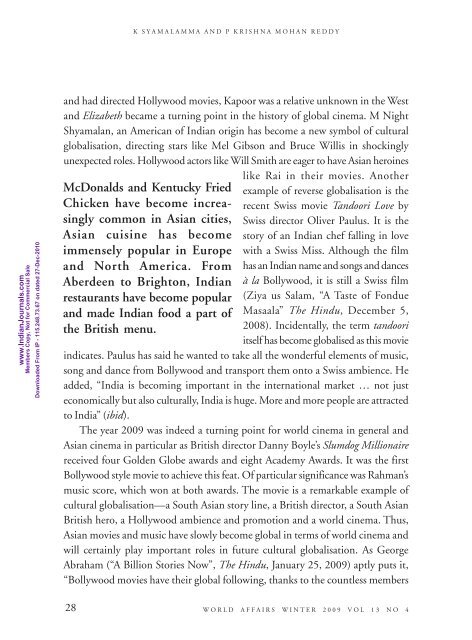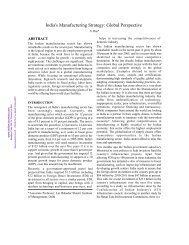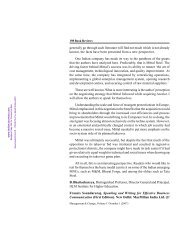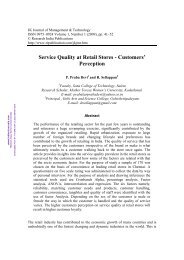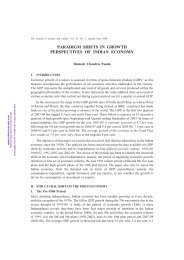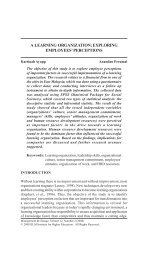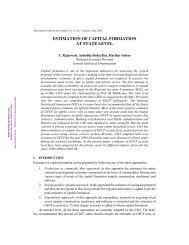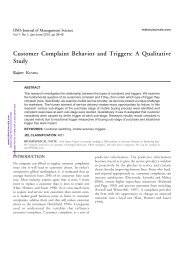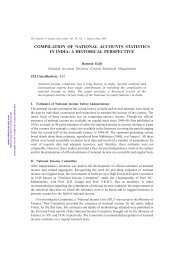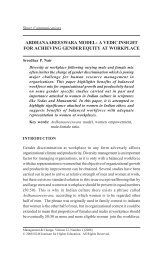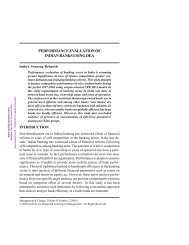Cultural Globalisation - Mimts.org
Cultural Globalisation - Mimts.org
Cultural Globalisation - Mimts.org
You also want an ePaper? Increase the reach of your titles
YUMPU automatically turns print PDFs into web optimized ePapers that Google loves.
K SYAMALAMMA AND P KRISHNA MOHAN REDDY<br />
www.IndianJournals.com<br />
Members Copy, Not for Commercial Sale<br />
Downloaded From IP - 115.248.73.67 on dated 27-Dec-2010<br />
and had directed Hollywood movies, Kapoor was a relative unknown in the West<br />
and Elizabeth became a turning point in the history of global cinema. M Night<br />
Shyamalan, an American of Indian origin has become a new symbol of cultural<br />
globalisation, directing stars like Mel Gibson and Bruce Willis in shockingly<br />
unexpected roles. Hollywood actors like Will Smith are eager to have Asian heroines<br />
McDonalds and Kentucky Fried<br />
Chicken have become increasingly<br />
common in Asian cities,<br />
Asian cuisine has become<br />
immensely popular in Europe<br />
and North America. From<br />
Aberdeen to Brighton, Indian<br />
restaurants have become popular<br />
and made Indian food a part of<br />
the British menu.<br />
like Rai in their movies. Another<br />
example of reverse globalisation is the<br />
recent Swiss movie Tandoori Love by<br />
Swiss director Oliver Paulus. It is the<br />
story of an Indian chef falling in love<br />
with a Swiss Miss. Although the film<br />
has an Indian name and songs and dances<br />
à la Bollywood, it is still a Swiss film<br />
(Ziya us Salam, “A Taste of Fondue<br />
Masaala” The Hindu, December 5,<br />
2008). Incidentally, the term tandoori<br />
itself has become globalised as this movie<br />
indicates. Paulus has said he wanted to take all the wonderful elements of music,<br />
song and dance from Bollywood and transport them onto a Swiss ambience. He<br />
added, “India is becoming important in the international market … not just<br />
economically but also culturally, India is huge. More and more people are attracted<br />
to India” (ibid).<br />
The year 2009 was indeed a turning point for world cinema in general and<br />
Asian cinema in particular as British director Danny Boyle’s Slumdog Millionaire<br />
received four Golden Globe awards and eight Academy Awards. It was the first<br />
Bollywood style movie to achieve this feat. Of particular significance was Rahman’s<br />
music score, which won at both awards. The movie is a remarkable example of<br />
cultural globalisation—a South Asian story line, a British director, a South Asian<br />
British hero, a Hollywood ambience and promotion and a world cinema. Thus,<br />
Asian movies and music have slowly become global in terms of world cinema and<br />
will certainly play important roles in future cultural globalisation. As Ge<strong>org</strong>e<br />
Abraham (“A Billion Stories Now”, The Hindu, January 25, 2009) aptly puts it,<br />
“Bollywood movies have their global following, thanks to the countless members<br />
28<br />
WORLD AFFAIRS WINTER 2009 VOL 13 NO 4


